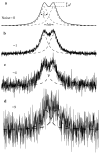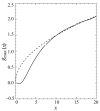On the voxel size and magnetic field strength dependence of spectral resolution in magnetic resonance spectroscopy
- PMID: 18687553
- PMCID: PMC2664077
- DOI: 10.1016/j.mri.2008.06.009
On the voxel size and magnetic field strength dependence of spectral resolution in magnetic resonance spectroscopy
Abstract
While the inherent low sensitivity of in vivo MR spectroscopy motivated a trend towards higher magnetic fields, B(0), it has since become apparent that this increase does not seem to translate into the anticipated improvement in spectral resolution. This is attributed to the decrease of the transverse relaxation time, T(2)*, in vivo due to macro- and mesoscopic tissue susceptibility. Using spectral contrast-to-noise ratio (SCNR) arguments, we show that if in biological systems the linewidth (on the frequency scale) increases linearly with the field, the spectral resolution (in parts per million) improves approximately as the fifth-root of B(0) for chemically shifted lines and decreases as about B(0)(4/5) (in hertz) for a structure of J-coupled multiplets. It is also shown that for any given B(0) there is a unique voxel size that is optimal in spectral resolution, linking the spectral and spatial resolutions. Since in practical applications the spatial resolution may be dictated by the target anatomy, nomograms to determine the B(0) required to achieve the desired spectral resolution at that voxel size are presented. More generally, the scaling of the nomograms to determine the achievable spectral and spatial resolutions at any given field is described.
Figures








Similar articles
-
Theoretical signal-to-noise ratio and spatial resolution dependence on the magnetic field strength for hyperpolarized noble gas magnetic resonance imaging of human lungs.Med Phys. 2005 Jan;32(1):221-9. doi: 10.1118/1.1833593. Med Phys. 2005. PMID: 15719973
-
Blood oxygen level-dependent magnetic resonance imaging of the kidneys: influence of spatial resolution on the apparent R2* transverse relaxation rate of renal tissue.Invest Radiol. 2013 Sep;48(9):671-7. doi: 10.1097/RLI.0b013e31828b9830. Invest Radiol. 2013. PMID: 23571833
-
Region and volume dependencies in spectral line width assessed by 1H 2D MR chemical shift imaging in the monkey brain at 7 T.Magn Reson Imaging. 2004 Dec;22(10):1373-83. doi: 10.1016/j.mri.2004.10.005. Magn Reson Imaging. 2004. PMID: 15707787
-
Clinical applications at ultrahigh field (7 T). Where does it make the difference?NMR Biomed. 2016 Sep;29(9):1316-34. doi: 10.1002/nbm.3272. Epub 2015 Mar 12. NMR Biomed. 2016. PMID: 25762432 Review.
-
Detection of hidden metabolites by localized proton magnetic resonance spectroscopy in vivo.Technol Health Care. 1997 Dec;5(6):471-91. Technol Health Care. 1997. PMID: 9696165 Review.
Cited by
-
Enhancing Whole-Brain Magnetic Field Homogeneity for 3D-Magnetic Resonance Spectroscopic Imaging with a Novel Unified Coil: A Preliminary Study.Cancers (Basel). 2024 Mar 21;16(6):1233. doi: 10.3390/cancers16061233. Cancers (Basel). 2024. PMID: 38539565 Free PMC article.
-
Image superresolution reconstruction via granular computing clustering.Comput Intell Neurosci. 2014;2014:219636. doi: 10.1155/2014/219636. Epub 2014 Dec 28. Comput Intell Neurosci. 2014. PMID: 25610456 Free PMC article.
-
General technical remarks on 1HMRS translational research in 7T.Pol J Radiol. 2019 Apr 12;84:e190-e197. doi: 10.5114/pjr.2019.85147. eCollection 2019. Pol J Radiol. 2019. PMID: 31481990 Free PMC article.
-
GABA, Glutamate and Neural Activity: A Systematic Review With Meta-Analysis of Multimodal 1H-MRS-fMRI Studies.Front Psychiatry. 2021 Mar 8;12:644315. doi: 10.3389/fpsyt.2021.644315. eCollection 2021. Front Psychiatry. 2021. PMID: 33762983 Free PMC article.
-
Role of very high order and degree B0 shimming for spectroscopic imaging of the human brain at 7 tesla.Magn Reson Med. 2012 Oct;68(4):1007-17. doi: 10.1002/mrm.24122. Epub 2011 Dec 28. Magn Reson Med. 2012. PMID: 22213108 Free PMC article.
References
-
- Gruetter R, Weisdorf SA, Rajanayagan V, Terpstra M, Merkle H, Truwit CL, Garwood M, Nyberg SL, Ugurbil K. Resolution improvements in in vivo 1H NMR spectra with increased magnetic field strength. J Magn Reson. 1998;135:260–264. - PubMed
-
- Barker PB, Hearshen DO, Boska MD. Single-voxel proton MRS of the human brain at 1.5 T and 3.0 T. Magn Reson Med. 2001;45:765–769. - PubMed
-
- Thulborn KR. Why neuroradiologists should consider very-high-field magnets for clinical applications of functional magnetic resonance imaging. Top Magn Reson Imaging. 1999;10:1–2. - PubMed
-
- Ugurbil K, Adriany G, Andersen P, Chen W, Garwood M, Gruetter R, Henry PG, Kim SG, Lieu H, Tkac I, Vaughan T, Van De Moortele PF, Yacoub E, Zhu XH. Ultrahigh field magnetic resonance imaging and spectroscopy. Magn Reson Imaging. 2003;21:1263–1281. - PubMed
Publication types
MeSH terms
Grants and funding
LinkOut - more resources
Full Text Sources

